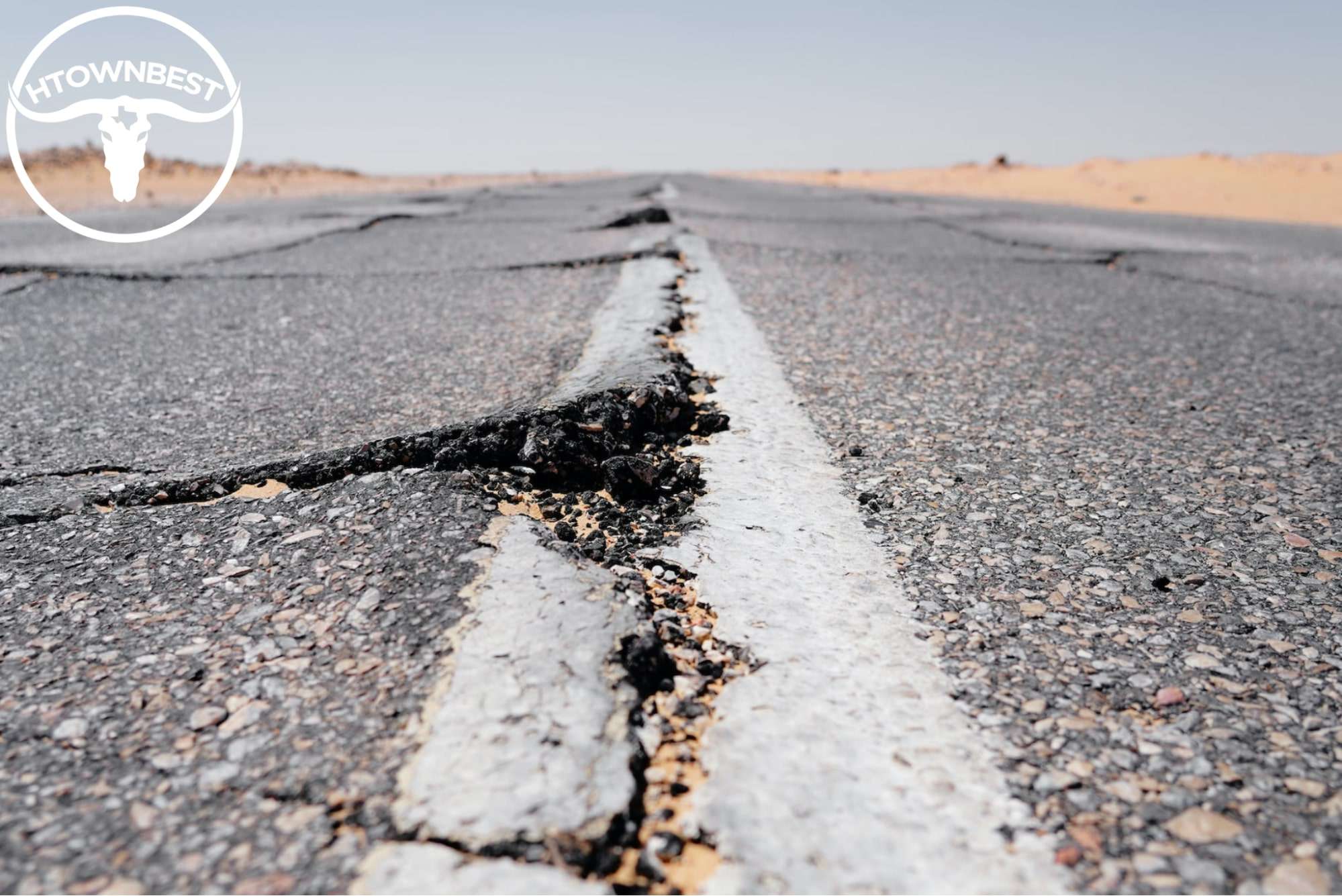Why are Houston roads so bad?

Houston, the beating heart of Texas, pulses with vibrant energy and ambition. Yet, beneath the city’s gleaming skyline and bustling streets lies a problem that has long plagued its residents: the sorry state of its road network.
Navigating Houston’s roads has become akin to a roller coaster ride, as potholes and uneven surfaces jolt drivers and commuters alike. Get ready to buckle up and explore the twists and turns that have led to the deterioration of Houston’s roads.
How bad are the roads in Houston?

A study conducted by the Houston-Galveston Area Council (H-GAC) revealed that nearly 25% of Houston’s major roads were in poor condition as of 2020.
This alarming statistic underscores the pervasive issue of subpar construction and highlights the urgent need for improvement.
In addition to the high percentage of poor road conditions, Houston’s roads are burdened with a high number of potholes, resulting from the use of low-quality materials and inadequate construction practices.
According to the City of Houston’s 311 Service Request Data, an average of over 17,000 pothole repair requests were received annually between 2018 and 2020.
The consequences of substandard construction practices extend beyond inconvenience.The poor road conditions contribute to increased vehicle maintenance expenses for Houston residents and businesses, ultimately affecting the local economy.
Houston’s bad road conditions can be attributed to natural factors like weather, clay soils, and layout, as well as socioeconomic factors like population growth, industrial traffic, and lack of funding and long term planning.
Extreme Weather Conditions

Houston’s road infrastructure has been significantly impacted by the extreme weather conditions it experiences, including frequent floods and prolonged droughts.
These weather events put immense stress on the roads, leading to rapid deterioration, increased formation of potholes, and compromised road quality.

Houston is no stranger to flooding, with heavy rainfall and occasional hurricanes posing a constant threat. The excessive water overwhelms the drainage systems, causing roadways to flood and remain submerged for extended periods.
This continuous exposure to water weakens the road foundations, resulting in soil erosion, pavement cracks, and the formation of potholes.
To grasp the severity of the issue, let’s look at the data from Hurricane Harvey in 2017. This devastating storm unleashed an unprecedented amount of rainfall, causing widespread flooding and wreaking havoc on Houston’s road infrastructure.
The Department of Transportation reported over 1,400 damaged roads and more than 800 bridges in need of repairs or replacement due to the floodwaters.

In addition to flooding, Houston experiences long periods of drought, with intense heat and dryness. During these extended dry spells, the soil under the roads contracts due to the lack of moisture, causing the road surfaces to shrink and crack too.
Consequently, the pavement becomes more prone to deformation, potholes, and reduced overall stability.
Expansive Clay Soils

The expansive clay soils in Houston known for their high shrink-swell potential, have a big impact on road stability and durability.
Expansive clay soils change in volume by significant amounts depending on the moisture content present. When exposed to water like in the raining season or during a flood, the clay absorbs water and expands.
On the other hand, during dry spells like droughts or the extremely hot summer days Houston can be known for, the water from the clay soil is evaporated into the air and it shrinks in size quite a lot.
This cycle of constant expansion and shrinking causes immense pressure on the road foundations, which leads to ground movement. When set concrete is moved too much and too often, it’s prone to cracks and deformations in the pavement.
Population Growth

The rapid population growth and expansive urban sprawl in Houston have contributed significantly to the deterioration of its road infrastructure.
The increasing number of residents and the expanding urban footprint have placed immense strain on the existing road network. This translates to daily traffic congestion, decreased road quality, and inadequate capacity to handle the growing traffic demands.
Houston has experienced substantial population growth over the past decades, with its metropolitan area now home to nearly 7 million people which is double the 2000 population of 3,800,000 million.

This population boom has led to increased traffic and more wear and tear on the roads. The existing roads, which were initially designed to accommodate lower traffic volumes, have become overwhelmed and eventually more and more damaged.
The Texas A&M Transportation Institute’s Urban Mobility Report provides insights into the impact of population growth on Houston’s roads. According to the report, Houston ranked as number 1 among the top cities in the United States for traffic congestion.
The study estimated that in 2020, Houston drivers spent an average of 53 hours stuck in traffic congestion. The longer the average time spent stuck in traffic, means the longer the time the roads have to bear the weight of vehicles causing more damage.
Urban Sprawl

Urban sprawl is characterized by the fast expansion of urban development into previously undeveloped areas. Houston, as a rapidly growing city, is definitely going through a fast-paced urbanization.
The sprawling nature of the city has led to the creation of many suburban communities far away from the city center and from places of businesses or government offices, which means longer driving distances for residents.
The sprawling development pattern has separated the neighborhoods and led to a greater dependency on private vehicles for transportation.

The lack of alternative modes of transportation, like comprehensive public transit systems or pedestrian-friendly infrastructure, just intensifies the reliance on cars, worsening congestion and road usage.
The increased travel distances contribute to adding to miles traveled and greater usage and ultimately damage on the roads. It doesn’t help that the rapid expansion often outpaces the capacity to plan and build new transportation infrastructure.
This leads to even more fragmented road networks, inefficient routes, and inadequate connections between different parts of the city.
Heavy Industrial Traffic

Houston is known as a major hub for industries like energy, manufacturing, and shipping. These commercial and industrial activities result in high volumes of transport vehicles and freight transportation on its roads.
These vehicles exert significant pressure on the road surface, causing accelerated pavement deterioration and structural damage.
The repeated heavy loads, especially on roads not designed to accommodate such traffic, can lead to cracking, potholes, and surface degradation, making the lifespan of the roads much shorter.

According to the TxDOT, approximately 40% of the state’s freight tonnage passes through the Houston area, making it one of the busiest corridors for commercial transportation in Texas.
The concentration of industrial facilities and shipping ports in Houston adds to the challenges faced by the road network.
The proximity of manufacturing plants, refineries, and distribution centers to residential areas and commercial hubs generates a significant amount of truck traffic moving in and out of the city.
Substandard Construction Practices

Substandard construction practices like the use of low-quality materials and non-fulfillment of construction standards, have resulted in a road network that is susceptible to premature wear, cracking, and potholes.
One of the main issues with Houston’s road construction is the use of subpar asphalt mixtures. Asphalt, a crucial component in road surfaces, provides strength, durability, and resistance to heavy traffic loads.
However, in an effort to reduce costs, some construction projects may use lower-grade asphalt mixtures or reuse old pavement removed from other roads. These lack the necessary resilience to withstand Houston’s demanding climate and high traffic volume.

Concrete road construction, although typically more durable, has also suffered from substandard practices. The quality of the concrete mix used in road construction is vital for long-term performance.
However, some projects have utilized inferior mixes that are more susceptible to cracking, spalling, and surface deformations.
Instances of construction standards not being upheld in Houston have only made things worse. Proper road construction involves precise layering and compaction of materials to ensure a solid foundation and even surface.
When these standards aren’t upheld, premature deterioration and increased vulnerability to environmental factors.
Insufficient Funding

Insufficient funding has been a major contributing factor to the poor condition of Houston’s roads. The city’s road infrastructure requires consistent and adequate funding to support regular maintenance, repairs, and infrastructure upgrades.
However, limited financial resources have hindered these efforts, resulting in a backlog of maintenance needs and a decline in road quality. The lack of adequate funding also directly affects the frequency and quality of road repairs.

Maintenance activities, such as resurfacing, filling potholes, and repairing cracks, require consistent funding to prevent small issues from escalating into more significant and costlier problems.
Houston’s road funding challenges stem from various sources, including budget constraints, competing priorities, and the increasing costs of construction materials and labor.
Data from the Houston-Galveston Area Council (H-GAC) reveals that the city faces a significant funding shortfall for road maintenance and improvements.
As of 2020, the estimated annual funding gap for transportation infrastructure in the Houston region exceeded $2 billion. This substantial deficit demonstrates the magnitude of the funding challenge and its impact on the condition of the roads.
Lack of Long-Term Planning

The lack of long-term planning and delayed construction and repair delays have significantly contributed to the deteriorating state of Houston’s roads.
The absence of strategic foresight and delayed infrastructure projects have resulted in inefficient road networks, inadequate maintenance, and prolonged disruptions for motorists.
Failure to anticipate future growth, population trends, and traffic demands has resulted in roads that aren’t ready to handle the increasing volume of vehicles.
This lack of planning has led to congestion, bottlenecks, and suboptimal road designs that cause traffic jams which then lead to a decrease in overall road quality.
Construction projects often face setbacks due to funding constraints, bureaucratic red tape, and inefficient project management. Houston is no exception.
These delays prolong the period of disruption and inconvenience for commuters while exacerbating wear and tear on already deteriorating roads.

One notable example is the I-45 North freeway project, which has experienced substantial delays. Initially scheduled for completion in 2022, the project faced multiple setbacks, including funding issues and legal challenges.
As a result, the completion date has been pushed back, prolonging the congestion and road deterioration experienced by commuters.
According to data from the Texas Department of Transportation (TxDOT), construction delays are a recurring issue in Houston.
In 2020, TxDOT reported that approximately 27% of construction projects in the Houston district faced delays, impacting the timely completion of road repairs and infrastructure upgrades.
These delays not only prolong the inconvenience for drivers but also contribute to the worsening condition of Houston’s roads.





